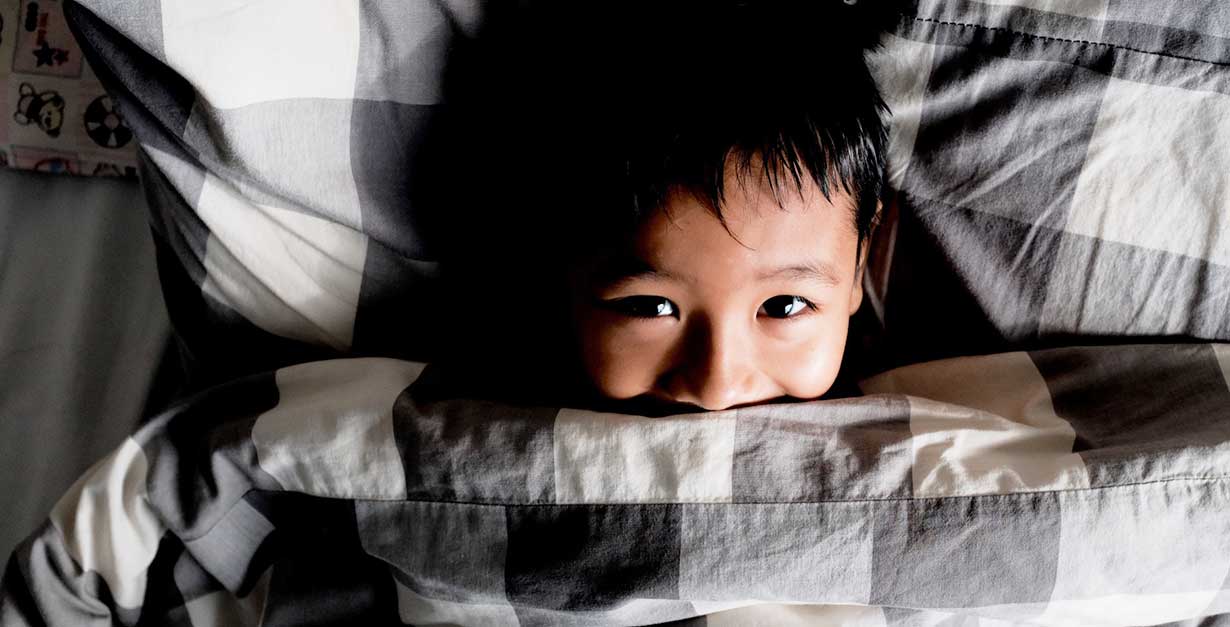Many parents breathe a sigh of relief once their child hits the toddler years. But then you’re dealing with molars, budding independence, and (for some) potty training. The 2 year old sleep regression can feel like a curveball just when you think you’ve finally mastered your toddler’s bedtime routine. One minute they’re sleeping soundly through the night, and the next, you’re facing bedtime battles, night wakings, and early-morning meltdowns. Understanding what’s behind these sudden sleep disruptions a year after the 12 month sleep regression can help you navigate through them with a bit more patience and hopefully, a little more sleep too.
2 Year Sleep Regression Signs
Common signs of a 2 year sleep regression include:
- Frequent night waking even when they previously slept through the night.
- Resisting bedtime with new stalling tactics like calling out for you repeatedly.
- Shorter naps or complete nap refusal during the day.
- Showing early morning wakeups or overall shorter sleep periods.
Logically, we think that development keeps moving forward, but when it comes to two year olds, you’ll notice that there’s a bit of backsliding as they learn new skills and grow up a bit, which includes the potential for the 2 year sleep regression. For this regression you’ll want to know about:
- Naptime/bedtime resistance
- Potty training
- Separation anxiety
- Handling with consistency and care
What is the 2 Year Old Sleep Regression
The 2 year old sleep regression can feel like a sudden, unwelcome surprise. Just when you thought your child’s sleep routine had settled, they suddenly start resisting sleep, fighting naps, or waking up multiple times during the night. Although commonly referred to as the 2 year old sleep regression, it can actually occur anywhere between 14 and 18 months, often aligning with major developmental milestones. In some cases, sleep disruptions may also arise as late as 21 or 22 months, depending on individual developmental progress.
During this phase, your toddler’s sleep patterns are influenced by their brain and body undergoing big changes. From newfound independence with walking and talking to milestones like potty training, these shifts can disrupt their once-peaceful sleep time. You may notice frequent night waking, bedtime resistance, or even refusal to nap during the day.
How Much Sleep Does a 2 Year Old Need?
Toddlers at this age typically need between 11 and 14 hours of sleep in a 24 hour period. This is often split between nighttime sleep (10 to 12 hours) and a daytime nap (1 to 2 hours). Poor sleep can lead to behavioral issues, crankiness, and difficulty settling at bedtime. Ensuring they get the right amount of rest according to their sleep needs is critical for their development. Following a consistent sleep schedule can help regulate your toddler’s sleep cycle and overall sleep patterns
What Causes Sleep Regression in Toddlers
Several factors can trigger sleep regression in toddlers, including:
Developmental Milestones
Significant developmental leaps, such as learning to talk, run, or potty train, are common triggers. These changes can make it harder for toddlers to relax and fall asleep. Growth spurts can also cause restlessness, affecting sleep. Sleep regressions are often tied to developmental progression—a sequence of physical, cognitive, and emotional growth that can temporarily disrupt established sleep patterns. From newfound independence to mastering new skills like language or climbing, these rapid changes challenge toddlers’ ability to settle down and relax.
Cognitive and Emotional Development
At this age, toddlers begin to assert their independence and test limits.Your little one might start diving into imaginative play and following multi-step instructions — exciting stuff! But with all these new skills, winding down for sleep can get tricky.
Physical Growth and Activity
New physical skills like climbing, running, and jumping may excite toddlers and contribute to restlessness at bedtime. Incorporating active play earlier in the day can help ensure they are ready to wind down during sleep time.
Two Year Molars Sleep Disruption
Teething pain, particularly from two year molars, can lead to nighttime discomfort and sleep disturbances. Offering teething toys or consulting a pediatrician about pain relief can help.
Fears and Imaginations
Toddlers at this age may develop nighttime fears, such as fear of the dark or imaginary monsters. Introducing a comforting nightlight or stuffed animal can help ease these anxieties.
Separation Anxiety and Nighttime Fears
You may notice that your once-independent toddler is suddenly clingy and afraid to let you leave the room. Part of this is your toddler’s imagination, which is a wonderful thing, until she starts imagining that there are monsters under the bed. This is totally normal, and may cause some bedtime resistance. Separation anxiety often peaks around this age. Spending 10 to 15 minutes of intentional one-on-one time during the day can reduce bedtime struggles and foster security, improving your child’s sleep.
Toilet Training
Some 2 year-olds are ready to be potty trained, while other children aren’t ready until closer to 3. If your child is working on potty training, expect that her focus in other areas (like sleep) may regress a bit, as learning such a big skill takes a lot of concentration and effort.
The 2 year Sleep Regression – What Happened?
You may find that your 2-year-old who was sleeping perfectly every night is now up multiple times. Or your partially potty trained toddler suddenly can’t remember to use the bathroom half the time. Or maybe your perfect napper suddenly screams all through naptime. The 2 year sleep regression is enough to drive parents crazy with all of the development and changes that are occurring.
In reality, it’s a very good sign! It means that your toddler’s knowledge and skills are advancing and that they are sacrificing sleep to master another skill. Frustrating as this may be, consider this:
Your Child’s Awake Time Has Lengthened
Your toddler is down to just one nap, and only needs 10 1/2 to 11 hours of sleep every night. This can take some getting used to, and also means that you may experience a rash of nighttime awakenings.
Wondering about appropriate naps at 2?
Read: Baby and Toddler Naps — Everything You Need to Know
Naptime Resistance
2 year-olds are known for testing (and re-testing) boundaries. One of the most common hot spots is naptime. Your toddler is going to test boundaries. She knows that life goes on while she’s napping, and she’s not okay with that anymore. This phase can be incredibly frustrating, because a toddler who fights naps is a very tired toddler indeed.
Two year-olds think they are ready to give up their naps, but we as parents know better.
When should you drop that last nap?
Read: Dropping The Afternoon Nap — Transitioning To Quiet Time For Toddlers
Bedtime Resistance
If you have a toddler, I’m sure that you’ve heard pleas such as “Just one more story, mom”, “5 more minutes”, “I just want to snuggle a bit longer”, and the ever-popular “One more drink, please?” These stall tactics are just that, stall tactics. Your child wants to see what she can get away with. It’s a power struggle, and she’s asserting her independence. If this is a regular occurrence, consider starting the nighttime routine earlier so that she gets to be one time AND gets her extra story.

How to Handle the 2-Year Sleep Regression
Like the other sleep regressions, the 2-year sleep regression may or may not affect your toddler. If you find that you’re suddenly dealing with a no-napping, bedtime-resisting, cranky ball of whine, then you’re probably looking at the 2 year sleep regression. The good news is that it may be the easiest regression to manage.
- Plan for Active Play: Ensure your toddler gets plenty of physical and mental stimulation during the day, such as running, climbing, or creative play with blocks.
- Avoid Big Transitions: Postpone major changes like moving out of a crib or potty training until your toddler’s sleep stabilizes.
- Stay Calm and Consistent: If your child gets out of bed, calmly guide them back without engaging emotionally. Repeat as needed.
- Adjust Nap Times: If naps become a struggle, evaluate whether your toddler’s wake windows need tweaking to avoid overtiredness.
- Use Positive Reinforcement: Celebrate small wins, like staying in bed all night or following the bedtime routine without resistance. A sticker chart or verbal praise can motivate toddlers to continue these positive behaviors.
Consistency is Key
As with anything sleep-related, consistency is key. Continue to nap on your toddler’s schedule, even if she just sits in her crib quietly for 45 minutes. Remember, most children nap until they’re 3, so stick with it. Likewise, continue your normal soothing bedtime routine, and make sure that you are keeping the same bedtime every night.
Avoid Making Assumptions
Many parents assume that if their toddler is resisting naps or sleep, that they really don’t NEED a nap anymore, or they should have a later bedtime. Developmentally, though, your toddler still needs her sleep. She still needs her nap and bedtime to be at an age-appropriate time, so make sure that you’re getting her into bed, even if she sits and sings for 45 minutes. You don’t want to move her bedtime later or skip naps, only to want them back in two weeks when she’s totally melting down from lack of sleep.
Set Some Rules
Toddlers (and all children, really) thrive on boundaries, and it’s up to us to set those for them. When it comes to sleep, make sure those items are non-negotiable. Bedtime is always 7:30 p.m. Naps happen at 12:30 to 1:00 p.m. every single day. Even if your toddler claims that she’s not tired, or doesn’t want to, make sure that she at least lies down and lets her body rest.
When all else fails, blame it on the clock. “See the clock? It’s 12:30, which means it’s time to rest for a bit.” Most 2 year-olds will not be able to read a clock, so if it helps, consider a wake up or toddler clock with a nap setting that changes the color or picture to indicate naptime and bedtime. Here are some of the toddler clocks we recommend.
Need to know what kind of schedule is best for your 2-year-old?
Read: Sample Schedules: Sleep and Naps From 6 Months to Preschool
Be Understanding About Your Toddler’s Fears
Nighttime fears are a big deal to our little ones. Your toddler has an incredibly vivid imagination, so take that into account and fuel it with good thoughts. Introduce (and encourage bonding with) a lovey, or do some light toddler yoga or visualization to help her relax.
Perhaps the best thing to remember about sleep regressions is that they’re temporary, usually lasting about 2-3 weeks. Your toddler may be a bit more snuggly, needy, or sleep resistant during this time, but follow your gut, don’t change the rules, and your 2 year-old will be sleeping through the night again soon.
If you find that these problems have been problems for years, or continue past 6 weeks, then it’s time to sleep coach.
Practical Tips for Dealing with Bedtime Issues
Here are some parent-approved tips to manage bedtime battles and encourage better sleep habits:
- Limit Screen Time: Avoid screens (TVs, tablets, phones) for at least one hour before bedtime. Studies show that screens can delay sleep onset and reduce overall sleep quality.
- Use a Nightlight: A soft light can help toddlers who develop nighttime fears or experience night terrors.
- Share Responsibilities: Alternate bedtime duties with your partner or a family member to reduce stress and maintain consistency.
- Control Environmental Factors: Ensure the sleep environment is quiet, dark, and comfortably cool. Blackout curtains or white noise machines can help eliminate distractions that disrupt sleep. Address any environmental issues, such as excessive light or household noise, that may make it harder for toddlers to settle.
- Stay Flexible: While routines are key, minor adjustments (like shifting bedtime earlier if naps are skipped) can help maintain balance.
- Replace Sleep Crutches: Many toddlers rely on sleep crutches—like rocking or feeding to sleep—that can become barriers to independent sleep. To help your child transition, gradually phase out these crutches by reducing the time spent on them each night. Replace them with positive sleep associations, like a favorite lovey or bedtime phrase, to encourage independent sleep skills
Sleep Training
1. The Sleep Lady Shuffle
Kim Says:
“The Sleep Lady Shuffle is my signature approach to helping toddlers who need sleep coaching learn to sleep while feeling supported and secure. You’ll start by sitting near your child’s bed or crib at bedtime, offering verbal and physical reassurance as they learn to self-soothe. Every three nights, you’ll gradually move farther away—from the cribside to the doorway, and eventually out of the room. This gentle method gives your child the confidence to fall asleep independently while knowing you’re still close by if they need you. Consistency is key—be patient, and you’ll see progress!”
2. Drowsy But Awake
Kim Says:
“Putting your child to bed ‘drowsy but awake’ is essential for teaching them how to fall asleep on their own. If you rock, nurse, or cuddle them to sleep entirely, they’ll struggle to replicate that when they wake during the night. By placing them in their bed when they’re calm but still awake, you allow them to practice the skill of self-soothing. It’s normal for your child to fuss or protest at first—it’s their way of saying, ‘Why are you changing things?’ Stay nearby, provide reassurance, and be consistent. They’ll learn to connect sleep with their own bed and feel proud of their accomplishment.”
3. Gradual Reduction of Sleep Crutches
Kim Says:
“Many toddlers rely on sleep crutches—like being rocked, nursed, or held—to fall asleep. While these are comforting, they can become a barrier to your child learning to self-soothe. I encourage parents to gradually reduce these crutches. For example, if you rock your child for 20 minutes, try reducing it to 15 minutes, then 10, and so on. Eventually, replace the crutch with a positive association, like a comforting lovey or a consistent bedtime phrase. This transition is gentle and sets the stage for lasting sleep independence.”
4. Positive Reinforcement
Kim Says:
“For toddlers, positive reinforcement can be a wonderful way to encourage good sleep habits. When sleep training your two year old create a ‘sleep manners chart’ where your child earns a sticker for staying in bed all night or following their bedtime routine. Celebrate their progress with verbal praise or a small reward, like an extra bedtime story. Keep the focus on their success and avoid punishing setbacks—it’s about building their confidence and motivation to keep up the great work!”
5. Consistent Bedtime Routines
Kim Says:
“A calming bedtime routine is a cornerstone of healthy sleep habits. Toddlers thrive on predictability, so establish a sequence of soothing activities—like a warm bath, a bedtime story, and a lullaby—that signal it’s time for sleep. Make sure the routine is consistent every night, even when traveling or visiting relatives. A predictable bedtime routine helps your child transition from the busyness of the day to the calm needed for a good night’s sleep.”
Why Not to Use Controlled Crying or Cry It Out
Kim Says
“Controlled crying or cry-it-out methods involve leaving your child to cry for extended periods without comforting them. While some families find these methods effective, I believe they can be distressing for both the child and the parent.
Crying is your child’s way of communicating—whether they’re scared, confused, or simply frustrated. When we don’t respond, it can feel to them as though we’re not listening or don’t understand their needs. This can disrupt the bond of trust that’s so essential to their emotional development.
My method, the Sleep Lady Shuffle, is designed to minimize tears while still teaching your child to sleep independently. By staying nearby and offering reassurance, you show your child that you’re there for them, even as you help them develop new skills. This approach fosters a sense of security and confidence that benefits their sleep and their overall emotional well-being.
Consistency and patience may take a little longer than cry-it-out, but the results are worth it—both for your child’s sleep habits and for your connection as a parent.”
Nap Refusal and Nap Issues
Nap time can be as challenging as nighttime sleep during regressions. Some toddlers go through nap refusal, especially around the 2.5 year mark, where they might resist naps altogether.
2 Year Old Stopped Napping
Some 2 year olds may suddenly stop napping as they transition toward needing less daytime sleep. It’s essential to monitor for overtiredness and maintain quiet time if your toddler resists napping.
Parenting Philosophy: Balancing Boundaries with Empathy
Regression phases are tough, but they’re also opportunities to reinforce healthy sleep habits. By staying consistent with boundaries while offering comfort and understanding, you can guide your toddler through this phase with confidence. Remember, your calm presence makes a difference.
Sleep Regressions at Other Ages
21 Month Sleep Regression
Often linked to transitions like dropping a nap or developmental leaps in language and problem-solving skills.
22 Month Sleep Regression
Common triggers include the development of molars, increased independence, or bedtime fears. Adjusting routines can help maintain restful nights.
24 Month Sleep Regression
The 24 month sleep regression aligns with increased independence, limit-testing, and transitioning to a toddler bed. These factors often lead to bedtime resistance and nighttime fears.
25 to 30 Month Sleep Regressions
As they approach age three, toddlers face significant developmental and emotional changes that can impact their sleep.
26 Month Sleep Regression
At 26 months, toddlers may experience disruptions due to heightened emotions, vocabulary growth, or increased independence. Reinforcing routines can provide a sense of security during this time.
29 Month Sleep Regression
The 29 month mark may involve adjustments to longer wake windows or skipping naps altogether. Ensuring a consistent bedtime and offering quiet time can help manage these changes.
Toddler Sleep Problems
Sleep regressions are a natural part of toddlerhood, but understanding when they occur and how to manage them is crucial for both toddlers and parents.
When Do Toddlers Go Through Sleep Regressions
Sleep regressions typically occur at 4 months, 8 to 10 months, 12 months, 18 months, 2 years, and 2.5 years. Each stage reflects a period of significant physical, emotional, or cognitive development that impacts sleep patterns and cycles.
General Sleep Refusal and Sleep Issues
For some parents, the primary sleep challenge is not just night waking but outright refusal to sleep. You might encounter various behaviors, such as needing parental comfort, stalling, or resistance to bedtime.
2 Year Old Awake for Hours at Night
Occasionally, toddlers wake up and remain alert for hours. This can result from irregular nap schedules, overstimulation, or overtiredness. Gradual routine adjustments and minimizing nighttime interaction can help.
2 Year Old Baby Crying at Night for No Reason
Unexplained nighttime crying might result from developmental fears or physical discomfort like teething or illness. Offering brief comfort and ensuring a soothing sleep environment can reduce these occurrences.
Conclusion
Navigating the 2 year old sleep regression can be exhausting, but with the right strategies and patience, you’ll get through it. This phase is temporary, and while sleep might feel like a distant dream, consistency is key. By maintaining a calming bedtime routine, being mindful of your toddler’s changing sleep needs, and offering comfort without creating new habits, you’re setting your little one up for success. Sleep regressions are tough, but they’re also a sign that your child is growing and developing in exciting ways. Hang in there restful nights are just around the corner
FAQ
Q: Is it okay if my 2 year old doesn’t nap
A: While most 2 year olds still need a daily nap, some may resist it around this age. If your child is getting enough sleep at night (about 10 to 12 hours), skipping occasional naps might be fine. Watch for signs of overtiredness, like crankiness or struggles to stay awake, and encourage quiet time or an earlier bedtime if needed.
Q: How long does the 2 year old sleep regression last
A: The regression typically lasts 2 to 6 weeks, though it varies. It’s usually triggered by developmental milestones and is temporary. Consistent routines and patience help toddlers transition back to regular sleep patterns.
Q: Why is my 2 year old not sleeping
A: Possible reasons include developmental milestones, separation anxiety, routine changes, or overtiredness. Teething, nightmares, or illness can also disrupt sleep. Maintain a consistent bedtime routine and monitor for changes that could affect sleep.
Q: What should I avoid during the 2 year sleep regression
A: Avoid creating habits that could lead to long-term sleep issues, like letting your toddler sleep in your bed. Stick to routines, avoid major transitions, and keep responses to night wakings calm and brief.
Q: Can the 2 year old sleep regression start early
A: Yes, it can start as early as 18 months due to developmental changes. The key is to recognize the signs early and stay consistent with bedtime routines to help your child through this phase.
Q: What are the signs of a 21 or 22 month sleep regression?
A: These regressions can look similar to others, with frequent night wakings, nap resistance, or bedtime struggles. Often caused by developmental leaps, molar teething, or heightened independence, they can be managed with consistent bedtime routines and offering comfort while encouraging self-soothing.
Citations
- Janssen, X., Martin, A., Hughes, A., Hill, C., Kotronoulas, G., & Hesketh, K. (2019). Associations of screen time, sedentary time and physical activity with sleep in under 5s: A systematic review and meta-analysis. Sleep Medicine Reviews, 49. https://doi.org/10.1016/j.smrv.2019.101226.
- CDC, “Important Milestones: Your Baby by Two Years,” Centers for Disease Control and Prevention, October 22, 2018, https://www.cdc.gov/ncbddd/actearly/milestones/milestones-2yr.html.
- E. Jansen, W. Zhao, A. Jones, T. Marshall, K. Neiswanger, J. Shaffer, D. McNeil, M. Marazita and B. Foxman. “Early Childhood Diet in Relation to Toddler Nighttime Sleep Duration Trajectories.” Nutrients, 14 (2022). https://doi.org/10.3390/nu14153059.
- Amanda Prokasky, Matthew S. Fritz, V. Molfese and J. Bates. “Night-to-Night Variability in the Bedtime Routine Predicts Sleep in Toddlers.” Early Childhood Research Quarterly, 49 (2019): 18-27. https://doi.org/10.1016/J.ECRESQ.2019.05.004.
- Holliday-Bell, Angela. “A Parent’s Guide to Sleep Training Infants and Toddlers – UChicago Medicine.” UChicago Medicine, 24 May 2023, www.uchicagomedicine.org/forefront/pediatrics-articles/2023/may/sleep-training-in-infants-and-toddlers.
- Yamaguchi, Masanori et al. “Exploring role of sleep aids in sleep problems in preschool children.” Scientific Reports vol. 13,1 6612. 24 Apr. 2023, doi:10.1038/s41598-023-33758-z.
- Ponti, Michelle. “Screen Time and Preschool Children: Promoting Health and Development in a Digital World.” Paediatrics & Child Health, 28, no. 3 (May 16, 2023): 184–92. https://doi.org/10.1093/pch/pxac125.
- Staton, S., Rankin, P., Harding, M., Smith, S., Westwood, E., LeBourgeois, M., & Thorpe, K. (2019). Many naps, one nap, none: A systematic review and meta-analysis of napping patterns in children 0–12 years. Sleep Medicine Reviews, 50, 101247. https://doi.org/10.1016/j.smrv.2019.101247.
- Field, T. (2017). Infant sleep problems and interventions: A review. Infant Behavior & Development, 47, 40-53. https://doi.org/10.1016/j.infbeh.2017.02.002.
- Cleveland Clinic. “Infant Sleep Regression: What Parents Need To Know.” https://health.clevelandclinic.org/the-4-month-sleep-regression-what-parents-need-to-know.
- National Institutes of Health. “Melatonin: What You Need to Know.” NCCIH, January 2021. https://www.nccih.nih.gov/health/melatonin-what-you-need-to-know#:~:text=Melatonin is a hormone that.




